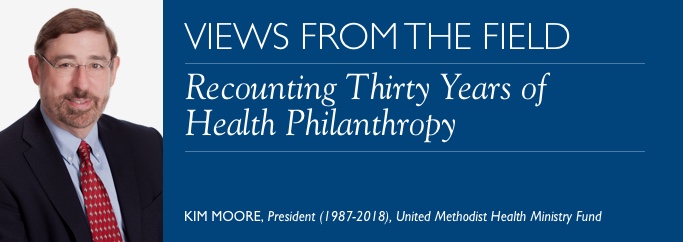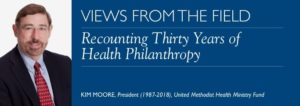
In 1987, the opportunity to lead a new health foundation was appealing enough for me to leave a partnership in a thirty-five-person law firm. I believed the new job would permit reacquaintance with my wife and three young children and the opportunity to make the world a little better. That was enough to overcome the sixty percent reduction in pay, the unhappiness of a move for our children, and the tearing of personal ties and career expectations associated with the practice of law.
Managing Early Expectations
Like most conversion foundation beginnings, ours had its set of historical expectations and lingering control issues. Because our funding was a free and independent decision by the Kansas West Conference of the United Methodist Church on the use of a share of the proceeds of a hospital sale, the relationship to the Church and its progeny institutions and agencies to the Health Ministry Fund was critical to establish from the outset. There were many who expected the Health Ministry Fund to serve as an indirect endowment for their favored United Methodist institutions, agencies, and pet projects. A more effective role for this philanthropy was championed by the vast majority of the charter trustees who believed in the Conference-given mission of “advancing health, healing, and wholeness in Kansas” and knew that could not be accomplished with church-related investments alone.
In test after test, those charter trustees, with a little encouragement from me, refused permanent funding for retired ministers’ health insurance (costing one-fourth of our annual pay-out), expansion outside of Kansas for foreign mission projects, or making corpus-depleting grants to institutions and agencies of the Church. We adopted a conflict of interest policy making it very hard (culturally embarrassing at least) for staff or board members to push for projects of personal preference. I very deliberately resigned from board service with all groups in the Church which would be potential applicants. Our prophylactic culture probably moved so far that any personal entanglements with potential projects made it harder to fund those projects than others lacking an insider at the table.
What and How to Fund
In the midst of perceived or real pressure to “get money out the door,” a new funder has to find a funding approach which permits organizational learning; avoids extremely large, long-term commitments preventing a malleable future; and, yet, accomplishes as much as possible. We opted for an “over-the-transom” approach with rules galore (size of grant, length of term, no “this or that”, etc.) Luckily, we were in a state with only one other staffed funder open to requests of any size, and we received lots of good opportunities with this responsive approach. Quickly, it became clear that open grantmaking with its inherent advantage of responding to what organizations and people want to do with your money versus what a funder may really want done has a significant disadvantage—it is hard to have change at scale when the sum of the parts is impossible to determine or manipulate.
The Mythic Story for Us
For the Health Ministry Fund, an experience involving hospice care created change in how grantmaking occurred. This now “mythic” story can be summarized by saying that $1.5 million of targeted funding moved Kansas from four Medicare-certified hospices and hospice care in 20 counties to Medicare-certified hospices serving all 105 counties. This highly successful “initiative” involved restricted grants—only regional Medicare—certified hospices would be funded; a trip for Kansas hospice advocates to Kentucky where Medicare-certified, regional programs abounded; and funding to the Kansas Hospice Association to provide technical assistance
Strategic Funder
From that point in 1990-1992, we were always looking for ways to incentivize and organize targeted work developed frequently by information and experience from the continuing open door grantmaking which continued. Our “open door” ended in 2002 and we became fully strategic (as we understand it) with three selected fields of work anticipated to span six or more years. These strategic approaches grow from an in-depth planning process led by our board with structured inputs from nonprofits, state leaders, affected communities and fields; relevant data; and appraisal of similar, existing philanthropic efforts. Our first major strategic work in oral health lasted eleven years. Work is now moving forward in young children’s social and emotional health, rural health system reform, and improvement in breastfeeding initiation and duration.
Grantmakers In Health
About 1992, I became aware of a small “club” of health grantmakers who were operating as Grantmakers in Health. We had been active in our distant regional grantmaker association and communicated with the few other general grantmakers related to religious groups, but we had not been part of an association of like-minded health funders. GIH was in the midst of its first leadership change when I attended my first meeting. The room held 40-50 persons and most were from much larger foundations, although there were several of the very early hospital conversion foundations present (Sierra Health, Kansas Health). This was the start of an association which made huge differences for me as a foundation leader and for our organization.
What Has GIH Meant to Us?
GIH has been a constant source of “compare and contrast,” leading us to self-assess and change. The annual conferences, webinars, and publications provide in-depth information on what other health funders are doing and how they are succeeding (or not). These GIH offerings have provided us with opportunities to dig deeper with colleagues across the country into how philanthropy can succeed even with small pay-outs.
We have been challenged by philanthropic and nonprofit leaders to consider great themes running through our work and how to address them, i.e., inequities, racism/privilege, and cultural competence. The peer review team sponsored by GIH helped us reset our work as we prepared for the new president to come.
We have become aware of opportunities and needs through access to the best minds and leaders. The current work of the Health Ministry Fund in young children’s social and emotional health was inspired by the presentation by Dr. Nadine Burke Harris on adverse childhood experiences (ACEs) at a recent GIH annual conference. The operation of an oral health funders group, staffed by GIH for a period, was critical in our development of staged oral health change in Kansas as we learned about new methods of catalyzing oral health work and philanthropic practice to implement these.
We were encouraged in our work by the opportunities to share our own experiences through workshops and informal sessions at GIH meetings. This stage provided by GIH always resulted in new relationships and occasionally new resources for work in Kansas. Likewise, it helped us feel part of something bigger than small grants in central and western Kansas. We could sense participation in the national issues of our day through GIH engagement.
We developed as philanthropic leaders through the opportunities GIH gave staff and board members to learn and to share. Those “What is keeping you up at night sessions” were frequently where my board members discovered that the Health Ministry Fund was not doing mediocre work just because we were small and rural. With all our resources—facilities, networks, financial assets, church affiliation, staff, and board, we could be a philanthropy producing out of proportion change and that vision was energizing. My opportunity to be on the GIH board and to chair the Terrance Kennan Leadership Award in Health Philanthropy selection committee also improved my personal capabilities to do effective philanthropy.
Many thanks to the staff—past and present—of Grantmakers In Health and our colleagues in health philanthropy for the important role you have played in the thirty-year work of United Methodist Health Ministry Fund.

